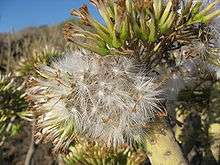Kleinia neriifolia
| Kleinia neriifolia | |
|---|---|
 | |
| Verode | |
| Scientific classification | |
| Kingdom: | Plantae |
| (unranked): | Angiosperms |
| (unranked): | Eudicots |
| (unranked): | Asterids |
| Order: | Asterales |
| Family: | Asteraceae |
| Subfamily: | Asteroideae |
| Tribe: | Senecioneae |
| Genus: | Kleinia |
| Species: | K. neriifolia |
| Binomial name | |
| Kleinia neriifolia Haw. | |
 | |
| Native range of K. neriifolia. | |
| Synonyms | |
|
Senecio kleinia Less. | |
Kleinia neriifolia also known as Verode or Berode and previously known as Senecio kleinia is one of flowering plant species of the genus Kleinia and in the daisy family (Asteraceae). It is native endemic to the Canary Islands and it used to be in the genus Senecio
Description
A succulent plant[1] Kleinia neriifolia has articulated branches (constrictions that make them look like rows of sausages)[2] and thick, stubby, elongated leaves which rest directly on the main stem or branch without a petiole or footstalk. Leaves growing clustered in crowded circles at the tops of the branches.[1] Trunk a meter high, and lanceolate leaves up to 12 centimetres (5 in) long.[2] Fragrant grey white flowers, blooms at any time between March and October. Deciduous, the leaves fall at the beginning of the dry season.[3] As with most arid habitat plants, reproduction is by reseeding only.[1]
Habitat
...these plants almost seem to live on air, yet they attain a considerable size; filled with sap they hang down in all their beauty from jagged rock, at first sight seeming to be purely superficial, but in reality sending their roots into crevices, and abstracting the water retained there by capillarity.
Eugenius Warming, 1909[1]
Berode grows abundantly in the Tabaibal-Cardonal zone or the arid, subtropical with steep and eroded substrates which are more pronounced and dominant in the eastern archipelago.[4] The vegetation can be compared with that of the arid areas of Sudan, Ethiopia, Arabia and Iran and is typical of the steppe in the African continent.[2]
Observations have been made about the relationships or communities that are formed between plants in such challenging conditions. In the case of the Canary Islands, the dominant Succulent tree (Euphorbia canariensis) with a supporting community of fellow halophiles: Verode (Senecio kleinia), Salt (Schizogyne sericea), Orijama (Cneorum pulverulentum), the Rubiaceae "Balo" (Plocama pendula) and also Tasaigo "typical" (Rubia fruticosa). It is indisputable that the tabaibales and cardonales are not climax (the highest point of anything conceived of as growing or developing or unfolding), but more like stadiums (a large structure for open-air sports or entertainments) or tesserae degradation of a former climax in harmony with its peculiar arid climate. For topographical position of cardonales, always in displaced situations, and the more open and typical serial or subserial of tabaibales, it seems close to the first climax potential. Species that are integrating communities also inclined to such subordination.[4]
Horticulture
The plant is used in gardens with dry conditions. The plant requires a minimum exposure of the sun. The minimum winter temperature it can endure is −2 °C (28 °F).[3]
Kleinia neriifolia has been successfully cultivated as a houseplant and as landscaping. It is on a list of suggested fire safe landscaping.[5]
References
- 1 2 3 4 Warming, Eugenius (1977) [1909]. "32 Storage of Water by Land Plants". Oecology of Plants. 300 Bedford Street, Manchester, NH: Ayer Publishing. ISBN 0-405-10423-5.
- 1 2 3 "Canary Islands Flora - Arid Habitat". Retrieved 2008-03-02.
- 1 2 Elio Darcangeli. "LE PIANTE - Senecio kleinia". PIANTE GRASS and SUCCULANTS (in Italian). Retrieved 2008-03-02.
- 1 2 S. Rivas Goday y F. Esteve Chueca. "Ensayo fitosociológico de la "Crassi-Euphorbieta" macaronesica y estudio de los tabaibales y cardonales de Gran Canaria" (PDF). Anales del Jardín Botánico de Madrid (in Spanish). Real Jardín Botánico de Madrid: Real Jardín Botánico de Madrid. 22 (1): 221–339. Retrieved 2008-03-02.
- ↑ Jeanette Knutson-Pedersen; California Department of Forestry and Fire Protection (July 2005). "Tree Notes" (PDF). Fire Safe Landscaping. Plumas Fire Safe Council. Retrieved 2008-03-02.
External links
![]() Media related to Kleinia neriifolia at Wikimedia Commons
Media related to Kleinia neriifolia at Wikimedia Commons
![]() Data related to Kleinia neriifolia at Wikispecies
Data related to Kleinia neriifolia at Wikispecies